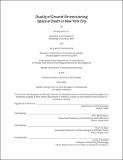Duality of Ground: Re-envisioning Space of Death in New York City
Author(s)
Lo, Kuang-Chun; Prachasartta, Jariyaporn
DownloadThesis PDF (68.63Mb)
Advisor
Mazereeuw, Miho
Ryan, Brent D.
Terms of use
Metadata
Show full item recordAbstract
The territory of death spans a wide range of space and time scales. New York City has, for centuries, been developed around and above the remains of the dead. Cemeteries, therefore, serve as a constant reminder of the mutability of urban ground and its profound notion of impermanence and perpetuity. Cemeteries, nonetheless, reveal as much about the living as they do about the dead. Today, their relevance has been challenged by the spatial constraints and the ever-changing perception of cultural and religious discourses and practices surrounding the place and space of death.
New Yorkers, religious and not, have started to favor cremations over burials for various reasons. This signifies that the spatial and socio-cultural relationship towards the cemetery environs will evolve as societal norms have diversified. Existing cemeteries, anachronistic and stagnant, mark a separation between activities of the living and places of the dead resulting in them transitioning into a monofunctional ground.
Individual death, although personal and intimate, makes up the discursive territory that enfolds identities, stories, and connections to the public whole. Therefore, the problems call for the need for communities to respond collectively. By taking the Cemetery Belt, a conglomeration of cemeteries at the border of Brooklyn and Queens, as a site of investigation, the thesis aims to re-envision the space of death and its role. The thesis proposes a design that mediates the balance and dynamism between conventional burial sites and new forms of engagement to create an urban experience that serves the journey of the dead and the living.
Date issued
2022-05Department
Massachusetts Institute of Technology. Department of ArchitecturePublisher
Massachusetts Institute of Technology